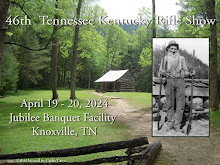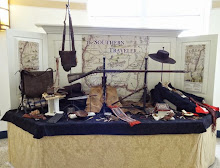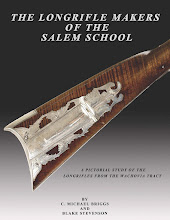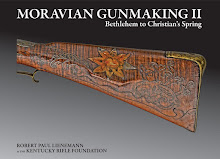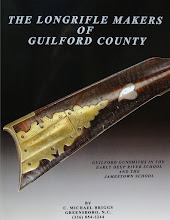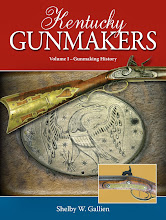16" length, 3.5" diameter wood plug with metal carrying ring. Rare engraved map horn of Pennsylvania depicting the sequential forts and way points on the trail from Philadelphia to remote Fort Pitt (Pittsburgh) at the strategic Forks of the Ohio. The track departing from the frontier post of Carlisle is the path of the famed "Forbes Road" built by an army of 5,000 British Regulars and colonial militia under the direction of General John Forbes (1707-1759).
Following the death of General Braddock during the ill-fated expedition against Ft. Duquesne in 1755, Forbes took command of British forces and commenced building a more direct road through 200 miles of trackless wilderness to attack the French at the strategic Forks. Hewn by hand from the primeval forest, the Forbes Road was 20 foot wide and traversed the Allegheny Mountains with fortified supply posts (Raystown and Ligonier) at supporting intervals. The rough road was sufficient to support wagons and artillery and was completed in November 1758.
The sudden appearance of a large British force from the forest gloom so intimidated the under-strength French garrison that Fort Duquesne was soon abandoned and burned. Forbes took control of the illusive prize on November 25, 1758 and ordered the post rebuilt naming it Fort Pitt. Gravely ill through most of the grueling march, Forbes soon returned to Philadelphia where he died on March 11, 1759.
Tracing Forbes' route the principal points are inscribed within simple rectangular cartouches, with adjacent buildings or forts characterizing the particular locations. Two major halls are depicted at Philadelphia, Lancaster, Carlile, and the reverse Shippinsburgh (with a bird embellishing the top of this cartouche. Fort plans are shown with Loudon, Lettelton, Stonneycreek (with reversed S's), Bedford and Ledgnear.
The terminus of the road is shown at the top of the horn where a large plan view of a fort, together with interior buildings and a detailed Union Jack flag at full mast is labeled Fort Pitt. The three rivers that converge at the fort, the Forks, are depicted and labeled Monagahaly, Ohio, and Allagany. Trees and floral forms are depicted on one side near bottom of horn.
Horn has fairly flattish base plug with a metal loop for a strap and what appears to be a shortened violin key as a stopper attached to the tip by a chain and metal band around the tip. The horn was likely carried and carved shortly after the construction of the new fort by a participant of the Forbes expedition as the place names generally correspond to the names known in 1758 culminating, of course, with Ft Pitt. The one possible exception is Bedford which was also called Raystown during the expedition.
Today parts of the Pennsylvania Turnpike and US Route 30 parallel the old Forbes Trail with key road markers westbound in Bedford and Westmorland County. As well as commemorating the Forbes Road and the ultimate capture of Ft. Duquesne, it is appealing to think of this historic horn in practical terms as a sort of portable road map anticipating the thrust of future frontier travel. Of course, the major significance of the Forbes Road in the decades following the French & Indian War was as a major land route into the heart of the prime Ohio country connecting Philadelphia and Pittsburgh.
Condition: This horn has a rich dark, untouched yellow-to-brown patina. An exceptionally scarce French and Indian War Map Horn of Pennsylvania. On a scale of one to ten, this is a ten.













































































